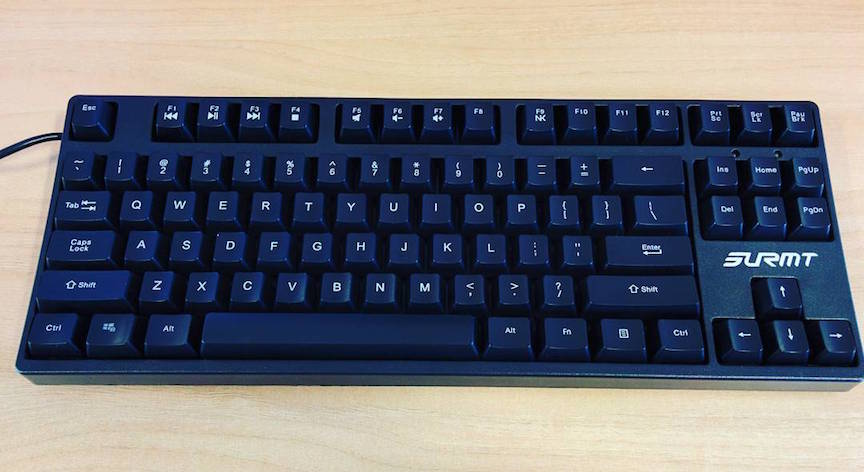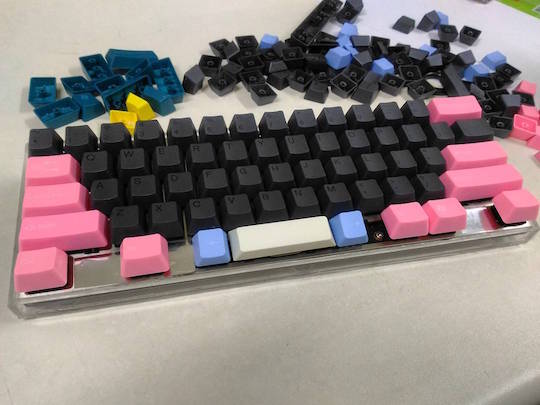Mechanical Keyboards
A few weeks ago I'd never heard of mechanical keyboards and if asked what one was I would have had no idea. A mechanical keyboard as opposed to a 'regular keyboard' is expensive, large, loud and specialist but with good reasons and I would recommend you look into getting one.
like instant vs freshly brewed coffee: both will keep caffeine withdrawal at bay, but one costs more and delivers a better experience

They're expensive
They cost more because under each key is a separate mechanical switch, which has been designed to give a particular sound and feel. The Cherry MX switch is the most popular switch, but there are also some cheaper clones which can mean a keyboard can cost £50 instead of £150.
If you like me did not know what a mechanical keyboard was - then this is another reason why they cost more, there is less demand for them. They are effectively a specialist item and my analogy would be: instant coffee vs freshly brewed, both are coffee and will keep caffeine withdrawal at bay, but one costs more and delivers a better experience.
They're large
My experience of mechanical keyboards has been of a large chassis containing aluminium or a thick, premium plastic. They also have additional weight of around 104 switches and reinforced keys. Some have no covering around the keys meaning you can see the whole switch, that is good for cleaning and a fresh look. The closed format looks very similar to a regular keyboard.
They're loud
Now this was a revelation for me - there is a kind of switch that is designed to be loud and clicky. The selling point is that the click gives feedback and lets the user type faster as you know whether a key was hit or not. I've included two recordings taken through a Nexus 5 placed a few inches away from the keyboard.
Soundcloud sample of a Cherry MX Blue keyboard:
https://soundcloud.com/alexellis2/chinese-mechanical-keyboard
Soundcloud sample of Cherry MX Brown switches:
https://soundcloud.com/alexellis2/sounds-of-cherry-mx-brown
If they both sound the same, listen out for a clicking noise in the first recording.
They're specialist
The first thing you need to know before buying a mechanical keyboard, is where and what you are going to use it for. It makes a difference due to the range of keys and customisations available.
A brief summary of switches:
-
Blue switches are the loudest and claim the best typing experience. The key has to be fully released before it can be tapped again. Do not buy this and expect to use it in an open plan office, unless there is a high level of background noise.
-
A brown switch has a slight bump in the key-press that gives additional feedback and feel without clicking. I think this is a safe option for an office environment.
-
Red switches are similar to brown, but have no bump in the actuation. These are pitched for gamers who need to rapidly repeat a key for firing/moving around in a game.
Other keys are available along with O-Rings which can be placed under the key to give a dampening effect. Most of the sound I've experienced is from heavy typing - where the key goes all the way down and hits the casing. Also note that some products may be sold with replica Cherry MX switches.
Keycaps
 Picture used with permission from @afuu_lin showing: Tai Hao ABS double shot keycaps
Picture used with permission from @afuu_lin showing: Tai Hao ABS double shot keycaps
Keycaps are the individual keys attached to each switch. These can be switched out to give a multi-colour effect. You can even buy keys with the text printed on the side of the key - or completely blank keys such as the Das Keyboard Ultimate model.
Backlit/Chroma/Macros
Some keyboards come with a single-colour backlight, LED chasing functions, macros and programmable keys. I won't talk much about this, but it is worth being aware that some products are aimed at hardcore gamers while others are aimed at programmers.
Layout
There are three main layouts you will find when buying.
- Full layout with number-pad
- Tenless layout with-out number-pad but with arrow keys and home/end/pg & up down keys
- Compact - This is like the tenless layout but has no F-Keys, these would be accessed through the function key.
Keyboard attempt #1
After reading up about all the switch types and listening to some recordings I decided I wanted the maximum typing experience and went for the Blue switches. I ordered the following product from Amazon which I also found on eBay in China.
Corlorful Backlit Chroma Dimmable Mechanical Gaming Keyboard 87 Keys Anti-Ghosting MX Blue Switches
It arrived in a plain cardboard box along with a free mouse-mat. I plugged it into a USB port and it worked straight away on a Mac, Windows 7 and Windows 10. There were several modes for the back-lighting from a constant lighting to a key-press chasing mode which could probably give your password away! The top plate of the keyboard was a plush and premium brushed aluminium, which gave it a very luxurious feel. It also had an open chassis meaning you could see the whole key and switch.
I used the product in a relatively quiet open plan office for about a week before the complaints started to roll in, fortunately Amazon offers returns and I found a category that summed up my problem in the form.
Before boxing the product up for return I tried it in my home office. I found the sound of the Blues to be getting on my own nerves as each key press was reverberating from the keyboard's aluminium open-top. One option was to add O-Rings under each switch, I tried this on several keys but found it made the typing experience less fluent.
Keyboard attempt #2
After much scouring of the interwebs I found a tenkeyless keyboard with Brown switches for under £40. I ordered on 10th Feb and it arrived on the 29th which is record timing for AliExpress/China.
Surmt CM625 87 Mechanical Gaming Keyboard

As pictured in place, at the office the model without number-pad gives plenty of space for a mouse. It was shipped in a plain box with a tool for removing key-caps and a warranty card, but nothing else. In comparison to the first product the sound is buttery and muted. It is also very weighty in its completely plastic shell. The text is printed onto each key rather than laser etched and can be felt as it is slightly raised.
If I have to be critical about this keyboard: the springs under the two Shift keys on the left and right feel different, one is slightly harder to depress. The keys which are stabilised by springs give off a slightly hard reverberation (space, shift, enter etc), but I have no idea whether this would sound better on a keyboard 3x the price.
Summing up
I think I've found the right mechanical for me - quiet enough to use in the office, sturdy build quality, the right price (think: 50% cheaper than an Apple wireless) and a satisfying fluent typing experience. Going back to a Microsoft Natural Keyboard now feels dull and slow in comparison.
Getting one
My buying advice would be to use a supplier which has no quibbles returns, so that if you are not happy with it you can try something different. Chasing a bargain is important for me, but getting the right layout and switches will pay dividends in the long-run, so I'd suggest doing plenty of research before committing to purchase. The reason I have bought with a US layout is that I have become used to the layout on my MBA, so don't want to have two layouts to contend with - be careful as often the product you will receive is not the same as pictured.
Suppliers in the UK:
eBay, Amazon, kustompcs.co.uk, keyboardco.com, overclockers.co.uk, dabs.com
Feel free to ask questions in the comments.